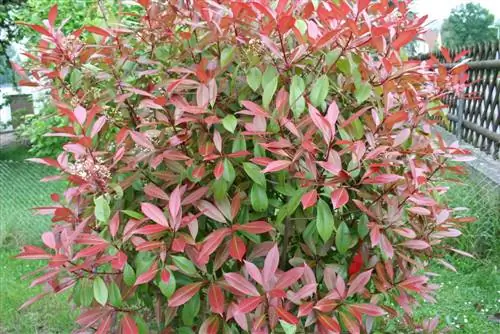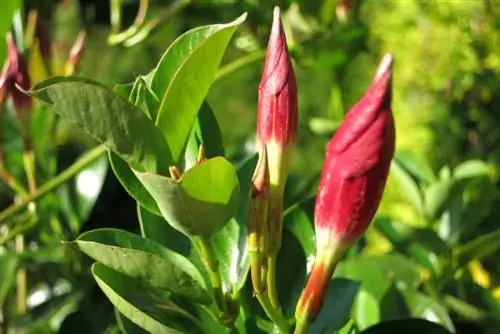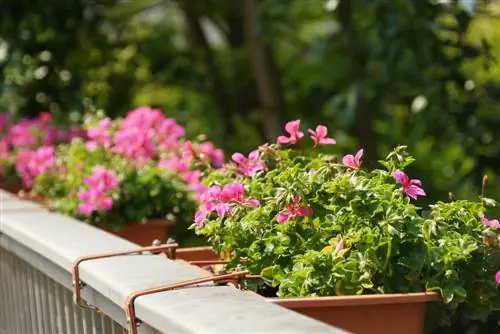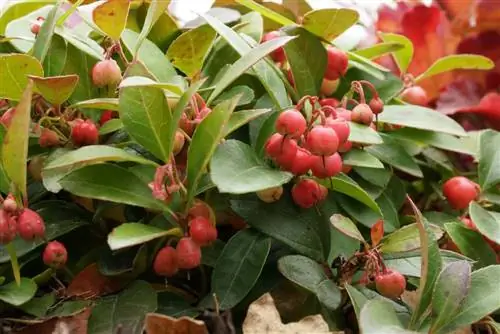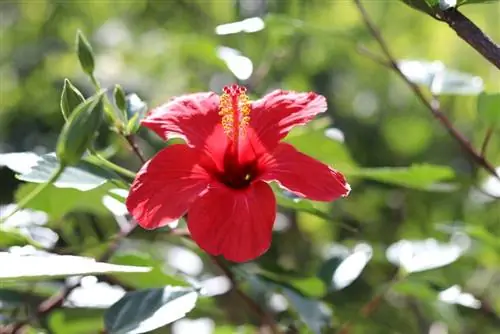- Author admin [email protected].
- Public 2023-12-17 03:39.
- Last modified 2025-01-24 12:45.
Winter-hardy potted plants are ideal for the balcony or garden as they can remain outdoors all year round and do not require protected winter quarters. Evergreen plants also have a decorative effect even at temperatures below zero. But which plant species are absolutely winter hardy, even if they are grown in pots?
There are a surprisingly large number of absolutely winter-hardy potted plants. Some of the plants are not only hardy, but also evergreen. This means they can decorate the terrace or garden even in the dead of winter.
Chinese Dwarf Lilac (Syringa meyeri)
The Chinese dwarf lilac enchants in spring with its abundance of flowers and is extremely robust. It can reach a height of up to one and a half meters and is therefore only partially suitable for balconies and other spatially restricted areas. The pink and purple flowers are not only a visual adornment, but also an enrichment for the animal world. Because bees and bumblebees find it a valuable source of food very early in the year.
Ginkgo (Ginkgo biloba)
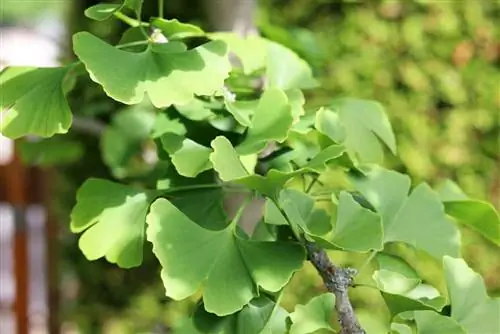
Easy to care for and undemanding, the ginkgo is extremely resilient and robust. Unfortunately, it is still relatively unknown that it can be kept in a bucket. The plant thrives easily even in smaller pots. In autumn, the ginkgo has a slightly yellowish color to its foliage, which means it can form a decorative contrast to evergreen plants.
Cotoneaster (Photinia x fraseri)
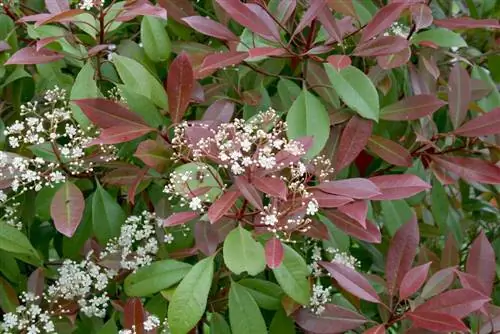
The loquat and especially the purple loquat are a highlight - especially from spring to autumn. The leaves of the plant continually change color during these seasons, from a light red to bronze to a rich green. The flowers of the evergreen plant are rather inconspicuous, but bright red fruits appear in summer.
Hydrogena (Hydrogena macrophylla)

The hydrangea is particularly known for its extraordinary flowers, but is also extremely robust and hardy. Therefore, it can easily be left outdoors during the cold season and can even be an eye-catcher. If the inflorescences are not cut off in autumn, they will still be a beautiful decoration in winter.
Japanese spindle bush (Euonymus japonica)
The Japanese spindle bush is evergreen, but does not flower and therefore does not produce any fruit. Nevertheless, it is a decorative addition to the garden or balcony, because the foliage offers an eye-catching play of colors. Robust and easy to care for, the Japanese spindle bush is also ideal for beginners in plant care.
Strap flower (Loropetalum chinense)
The strap flower is rather unknown, although it is hardy and evergreen and has a particularly decorative flower. The flowering period is between February and March and adorns the plant with pink-red, unusually shaped flowers. Even outside of this time, the reddish foliage is an eye-catcher and can provide variety in the greenery. In addition, the strap flower is comparatively easy to care for, compact and small in growth. This makes the potted plant suitable for smaller balconies, among other things.
Mockberry (Gaultheria procumbens)
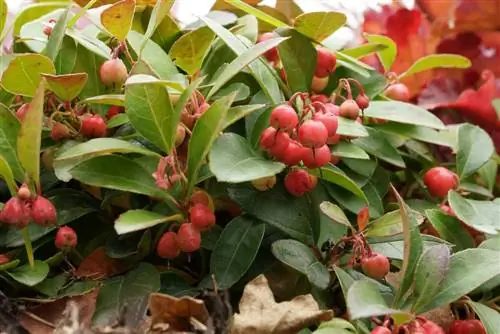
Green to red foliage and bright red berries adorn the false berry. Due to its compact growth habit, the plant is ideal for smaller balconies and corners in the garden. However, it must be noted that the plant is poisonous. To be on the safe side, the mock berry should therefore be avoided in locations that are accessible to pets and children.
Holly (Ilex)
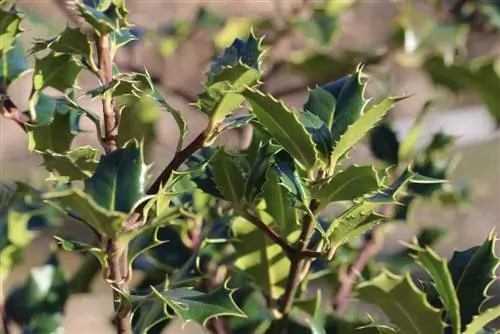
The holly is better known to many as Ilex and is often found as a hedge plant. However, very few people know that this robust plant can also be cultivated in a container. The holly is ideal as a container plant and can be made particularly decorative using topiary cuts. Another decorative factor are the bright red berries, which contrast wonderfully with the often patterned or rich green foliage. The evergreen plant is an eye-catcher even in winter.
Winter heather (Erica carnea)
The winter heather not only has good winter hardiness and, with the appropriate protection of the roots, can easily survive lower temperatures. It also blooms during the cold season. From around December to March, the winter heather is decorated with white to pink flowers and attracts everyone's attention.
Due to its small size, it is ideal for smaller balconies and niches and can be combined particularly decoratively with other plants.
Lemon balm (Melissa officinalis)
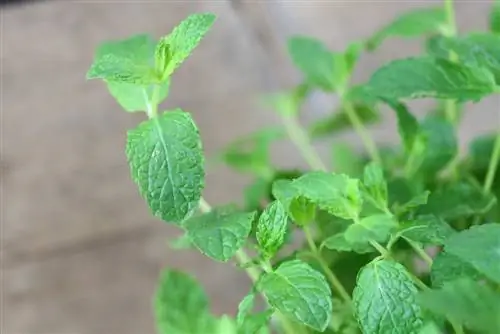
Lemon balm is known as an aromatic culinary herb as well as a medicinal herb. As an edible decoration on desserts, as an ingredient in salads, cocktails or as tea, fresh lemon balm is a tasty addition. What is hardly known, however, are the robust properties and winter hardiness of the plant. Even shoots of the plant can be harvested on frost-free days. This means that the evergreen culinary herb can enrich the menu all year round.
Dwarf pine (Pinus mugo var. pumilio)
The dwarf pine is evergreen and grows comparatively compactly. The plant reaches a maximum height of 1.5 meters, can be easily trimmed and is easy to care for. The robust plant can be cultivated in a pot without any problems and can therefore be placed on the balcony as well as on the terrace.
Care and Protection
Even if a potted plant is completely hardy, some protection and care is required so that the plant survives the winter he althy and strong. How the care should be depends, of course, on the respective plant. As a rule, however, the following points should be taken into account:
Protection
Insulating the pot by placing it on Styrofoam and wrapping it with garden fleece ensures that the substrate and roots cannot freeze completely. Smaller planters can also be placed in a larger pot, with the space in between filled with Styrofoam or straw. This means that the soil and roots remain absorbent for a longer period of time, making it easier to supply water and the plant to be cared for more easily.
Location
Whether the potted plant should be in the shade or in the sun depends, of course, on the particular plant. However, a protected location can always make sense so that the plant is not damaged by strong winds or persistent and intense rainfall.
Water
In winter, the plants should only be watered sparingly and on frost-free days. When watering the evergreen plants, it is important that the soil does not dry out completely. However, waterlogging must also be urgently avoided. Sufficient drainage is therefore essential after heavy rainfall and when located outdoors. If the location is shady, less watering is usually required.
Tip:
If the plant is in the shade, the water supply should be much more economical.

